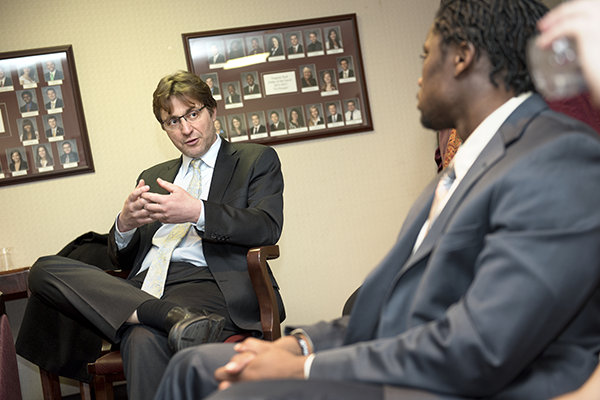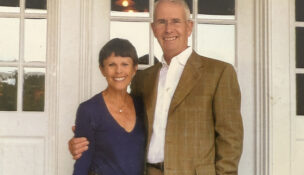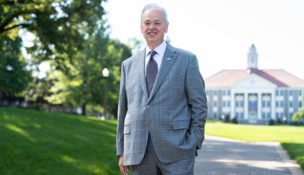Destination areas
Virginia Tech is developing a new way to tackle complex problems
Tim Thornton //September 29, 2017//
Destination areas
Virginia Tech is developing a new way to tackle complex problems
Tim Thornton //September 29, 2017//
Provost Thanassis Rikakis discusses the university’s Beyond Boundaries Destination Areas with a student group. Photos courtesy Virginia Tech
Virginia Tech is preparing for 21st-century competition.
“Because the knowledge game is a global game, the competition for talent in knowledge will be global,” says Virginia Tech Provost Thanassis Rikakis. “The institutions that will be able to compete in a global knowledge game will be first-rate institutions, and the institutions that won’t be able to compete in the global knowledge game will have the danger of becoming second-rate institutions.”
Virginia Tech does not intend to be second-rate. It has designated five “destination areas,” spheres in which the university intends to be a global leader by developing teams aimed at solving 21st-century problems. (See interview with Dennis Treacy, rector of the Virginia Tech Board of Visitors)
These teams will work not just across disciplines and traditional academic divides, but also across the boundary between campus and commerce, collaborating with companies and involving students in real-world challenges. A team might, for example, include engineers, designers, programmers, technical writers, marketers, company representatives and line workers.
That approach to problem solving may sound revolutionary, but Rikakis calls it evolutionary. Destination areas put interdisciplinary studies on steroids and yoke them to an expansive, modern interpretation of a land-grant university’s traditional mission.
New land-grant mission
Since Virginia Tech’s founding in 1872, land-grant colleges have sought to bridge the gap between academic study and practical application. The most visible manifestations were research stations and extension offices that applied science to agriculture. As society evolved, so did Virginia Tech’s focus. It still tries to close that gap between the academy and the economy, but the Virginia Corporate Research Center in Blacksburg may be more representative of the modern land-grant mission. It was created in 1985 to attract existing tech companies while incubating new ones.
Virginia Tech’s creation of destination areas is the next step, building on the university’s strengths to solve complex global, systematic problems. Virginia Tech still needs to do things that benefit Virginia, Rikakis says, but it needs to do them in a global context.
He says 21st-century problems are too big to fit inside one discipline. The university needs to bring all its knowledge to bear on those problems. But not all of them. “You can’t be a global leader in everything, right?,” Rikakis says. “You have to choose a few things for which you can be a global leader; you can be a global destination for talent. That doesn’t mean you stop being a comprehensive university. You’re still a comprehensive university.”
Choosing destination areas meant Virginia Tech had to focus in on its greatest strengths. “Nobody is going to believe you’re a leader in a complex space if you’re not a leader in the components of the space, right?” Rikakis says.
But strength within the constituent disciplines wasn’t enough. The university also needed strong partnerships beyond its campus, linking up with companies facing issues the destination areas are meant to confront. The last element was faculty buy-in. It’s difficult to succeed if the people leading and coordinating the effort aren’t enthusiastic about the mission.
For its first five destination areas, Virginia Tech chose: Adaptive Brain and Behavior; Data Analytics and Decision Sciences; Global Systems Science; Integrated Security; and Intelligent Infrastructure for Human-Centered Communities.
Intelligent Infrastructure
Intelligent Infrastructure provides a good example of how the destination areas were chosen and how broad they can be. This sector includes automated vehicle systems; smart design and construction; energy; and ubiquitous mobility, which the Virginia Tech website describes as the “location-agnostic promise of news communication and information technologies.”
“It just so happens that we’re great in all four,” Rikakis says. “So Intelligent Infrastructure was a great area for us to claim leadership because we were very, very good in the components. We just have to put them together and then re-imagine the built environment of the 21st century.”

The school combines research and education, exploring how different disciplines can cooperate on projects. That part is mirroring the real world, says Kleiner, who cites a recent visit to a construction company working with the university. A group of Tech graduates at the company included a construction program graduate but also an English major doing technical writing and another Hokie working in human resources. They told Kleiner that if they could have taken one class that had them working together before graduation, “We would have been six months ahead of the curve.”
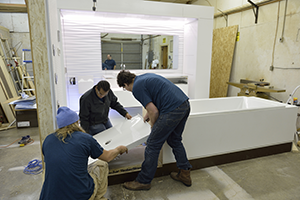
The school also involves students in all sorts of projects, including Elon Musk’s ultra-high-speed travel Hyperloop competition, FutureHAUS (Tech’s prototype house of the future) and an exoskeleton designed to help Lowe’s employees lift products more safely and easily. “We’re in a lot of different places,” Kleiner says.
Multidisciplinary drones
The Intelligent Infrastructure Destination Area will bring students from other disciplines together in the kind of teams they’re likely to join in the working world. Drones, Kleiner says, represent a good example of the kind of projects that could use a multidisciplinary team. A group working on drones might need aerospace engineers along with people equipped to deal with policy, laws, programming and even instruction manuals.
Much of Kleiner’s research deals with the interaction of humans and machines — “figuring out what the machine should do and what the human should do and not just automate because we have the ability to.”
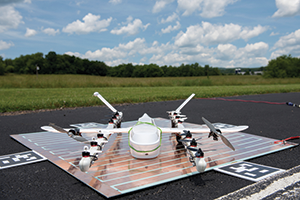
Below 500 feet, there has been little activity beyond medical helicopters and crop dusters, Blanks says. Now, there’s the potential for all sorts of hobby and commercial drone traffic. The test has as many as five unmanned aircraft in flight at a time, including one simulating a public-safety search, which requires other drones to adjust their flights to give the search vehicle priority.
The Intelligent Infrastructure Design Area got a boost in April. The university announced a $25 million gift toward the $78.45 million the university plans to spend on facilities for Intelligent Infrastructure. As a result, Rikasis says, Intelligent Infrastructure may get state-of-the art facilities sooner than other destination areas. See Fundraising.
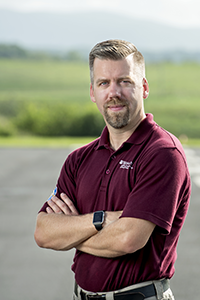
While drones get a lot of attention, they’re “just one piece of the pie for autonomous technology,” Blanks says, and Virginia Tech has its fingers in a lot of pies. Autonomous vehicles are moving on land and in water as well as in the air. Blanks says Virginia Tech is becoming the place to go for autonomous vehicle technology. “It’s more than just a test bed,” Blanks says. “We expect to see improvement in how we go about our daily lives.”
Blanks is talking about self-driving Uber-style cars and other innovations appearing in Blacksburg sooner than they show up in other places. “I think we’ll see the Jetsons-type age sooner than we expected because of the work going on here,” he says,
r

